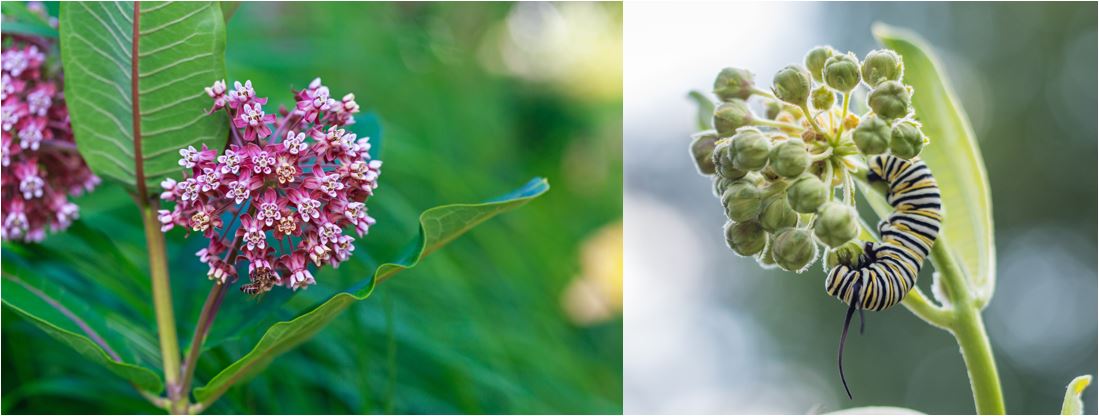3 Types of Milkweed in Alberta (AND One to Avoid!)
“What types of milkweed should I plant in my garden?”

This may seem like a crazy question if you’re just getting started with native gardening. Why would you want to plant a weed?!
But milkweed isn’t a weed at all. Instead, it’s a flowering plant that attracts butterflies (think Monarchs), native bees, and other pollinating insects, which is an excellent thing!
This article will give you information about common types of milkweed in your area and which ones will be best for your garden. And, keep reading to the end to learn about a kind of milkweed you want to avoid!
3 Types of Milkweed in Alberta:
#1. Green Comet Milkweed
- Asclepias viridiflora

Growing Information:
- USDA Hardiness Zone: 3-10
- Life Cycle: Perennial
- Approximate Mature Size: 45 to 60 centimeters
- Bloom Time: June to September
Green Comet Milkweed flower clusters form in the pocket created by the upper leaves. They’re made up of 20 to 80 small, pale green flowers. Interestingly, the yellowish-green leaves of this species vary in shape depending upon their habitat. Plants from moist sites tend to have rounder leaves, while plants from dry sites have long, narrow leaves.
In the wild, this species is often found on shaded roadsides, savannas, and prairies with moist to dry soil. In the garden, you can grow Green Comet Milkweed from seeds. It grows best in light to moderate shade but will tolerate full sun. Medium-dry to dry soil is best. Green Comet Milkweed doesn’t need rich soil and will tolerate sandy or rocky soil with low organic matter.
This species is a good choice for low-maintenance gardens as its long taproot allows it to tolerate drought well. Unlike many other milkweeds, this species is easy to prevent from spreading. It doesn’t form the large colonies typical to other milkweeds, so it’s an excellent option for smaller gardens!
The Green Comet Milkweed’s copious nectar and sweet fragrance attract many pollinators, including honeybees, native bees, and butterflies. It’s also a host plant for Monarch Butterflies, though it can be more challenging for monarchs to find because of its scarcity and preference for partial shade.
#2. Showy Milkweed
- Asclepias speciosa

Growing Information:
- USDA Hardiness Zone: 3-8
- Life Cycle: Perennial
- Approximate Mature Size: 145 to 90 centimeters; occasionally up to 3 meters
- Bloom Time: May to September
As the name suggests, Showy Milkweed features flashy pink and white umbels or clusters of small flowers. The flowers are fragrant, and individual flowers look a bit like crowns. In ideal conditions, Showy Milkweed may grow as tall as 3 meters!

As a garden plant, Showy Milkweed has the benefit of being a less aggressive spreader than most other milkweed varieties in Alberta. It can be grown easily from seed or the cuttings of an existing plant. It’s very drought tolerant and can be grown in a wide range of soils.
Like other milkweeds, Showy Milkweed attracts native insects and Monarch Butterflies to your yard or garden. Monarchs will visit the flowers for nectar and lay eggs on the plants, which are host plants for the Monarch caterpillars. It will also attract beautiful Queen and Viceroy butterflies to your property!
RELATED: 19 Rabbit Resistant Plants to grow in Alberta!
#3. Oval-leaved
- Asclepias ovalifolia

This lesser-known milkweed plant can be tricky to spot in Alberta! The slender, unbranched stems do not grow very tall, making them blend in with the surrounding plants. Look for it growing in dry soil in prairies, savannas, dry riparian terraces, and open pine woodlands.
As the name suggests, Oval-leaved Milkweed has opposite, oval-shaped leaves that are a little broader at the base and narrow to the tip.
Oval-leaved Milkweeds usually flower between May and July. Typically, the flowers are white with some pale green or pinkish-purple tones and often fade to yellow with age.
The flowers give way to narrow, spindle-shaped pods. These erect pods mature to brown and split open along one side to release brown seeds with silky pappuses that are spread by the wind.
Tropical Milkweed
- Asclepias curassavica

Growing Information:
- USDA Hardiness Zone: 8-11
- Life Cycle: Perennial
- Approximate Mature Size: up to 1.5 meters
- Bloom Time: March to November in temperate climates, year-round in tropical climates.
This non-native milkweed plant has become popular in recent years because of its flowers’ bright red coloring and how easy it is to plant and maintain.
Unfortunately, Tropical Milkweed planted in Alberta may do more harm than good.
It carries a parasite of Monarch Butterflies called Ophryocystis elektroscirrha, or OE, which can cause defects in the wings of Monarchs. Since it doesn’t die back and can bloom late, the plant itself may also confuse Monarchs by signaling a breeding season when it’s time to migrate.
To ensure you’re planting milkweed that will help your local ecosystem and attract native pollinators, always choose a native species!
Marketers of Tropical Milkweed seeds will use the names Mexican Milkweed, Bloodflower, Mexican Butterfly Weed, Mexican Orange Milkweed, and Semi-Tropical Milkweed. Steer clear of all of these!
Are you looking for more information on milkweed in Alberta?
Check out this guide!
Do you have milkweed in your garden?
What’s your favorite thing about this plant? Leave a comment below!


